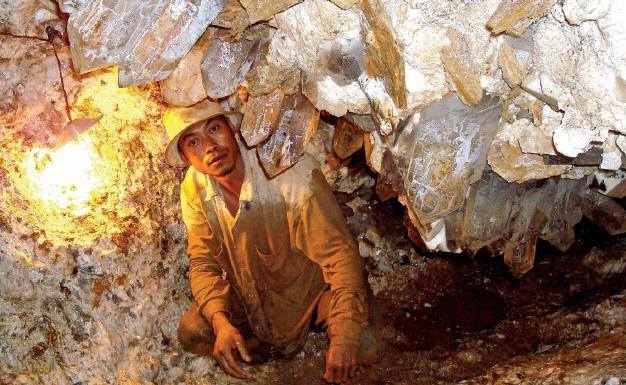
Miner with huge quartz crystals inside the pocket. Saw Naung U photo.

Huge quartz, feldspar, mica and topaz crystals (at the center) in the pocket. Saw Naung U photo.
Quartz
Quartz is one of the most importantmineral species, occurring in all biggerpockets in Sakangyi. Its habit is classicallyprismatic, usually with medium-lustrousor very lustrous crystal faces,sometimes preferentially frosted. Thevast majority of the crystals are white orcolorless and transparent. Yellowish, pinkor smoky varieties are much more rare.
Quartz crystals often show a well developedparquet pattern on prism faces.
Usually crystals grow in the pocketsas a continuation of the pegmatite’sgraphitic texture. Thus all of their freegrowingparts protrude in the same directionin relation to big K-feldsparcrystals.
Some of the pockets contain quartzcrystals which were broken and rehealedin the crystallization process.
The most common size of quartzcrystals from the Sakangyi mines variesfrom a few to 20 centimeters, but there are also giant crystals known. Thebiggest one weighs 78 kg, while some ofthe clusters reach almost 200 kg!
What is more, small (3-4 cm), Japanlaw-twinned quartz crystals showing thetypical flattened habit are known fromthe locality.
Hair-like inclusions of rutile are reportedin some quartz crystals.
Clean quartz is usually used as agemstone or carving material, but wellformed crystals, especially when associatedwith other minerals, are frequentlysold as mineral specimens.
Scheelite
Scheelite crystals in Sakangakyi arerare but sometimes of good quality. Theyreach 2-3 cm and are usually yellow,orange or white; some green crystalshave been reported. Sometimes parts ofthe crystals are gemmy. Their habitis pseudo-octahedral, typical for thespecies.
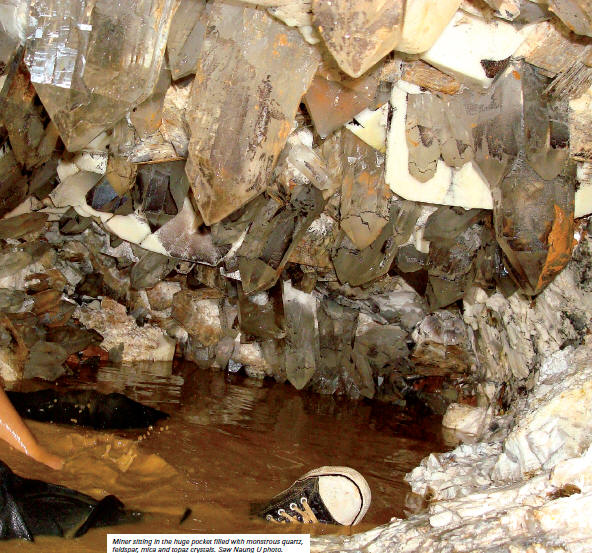
Miner sitting in the huge pocket filled with monstrous quartz, feldspar, mica and topaz crystals. Saw Naung U photo.
Miners carrying out a huge specimen using bamboo. Saw Naung U photo.

Specimen of topaz, quartz and feldspar over 35 kg. F. Bärlocher photo.
Other minerals
known fromSakangyi are columbite-tantalite, danburite,hessonite, rutile, sillimanite, thoriteand uraninite.
POCKETS
Even more exciting than the mineralsthemselves are the pockets discoveredthrough the years in the Sakangyimines. We know very little about the majorityof them because they were treatedas “secrets” of the mine owners and alsobecause, as mentioned above, the Mogokarea is closed to foreigners.
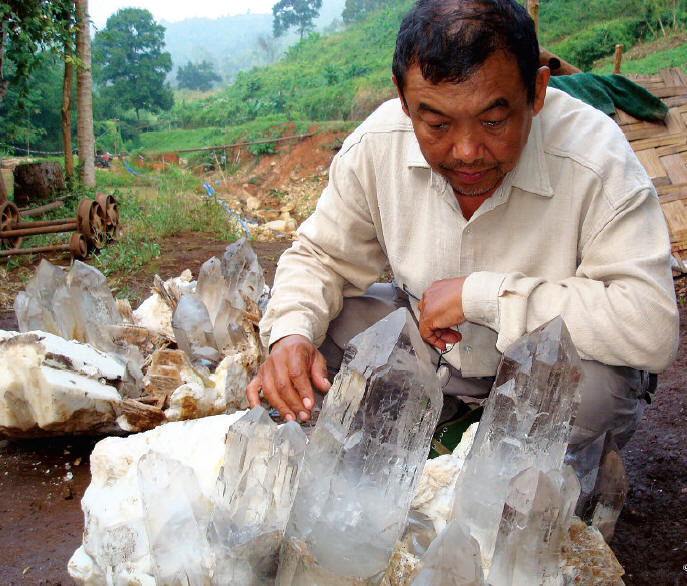
Examining freshly extracted specimens. Saw Naung U photo.
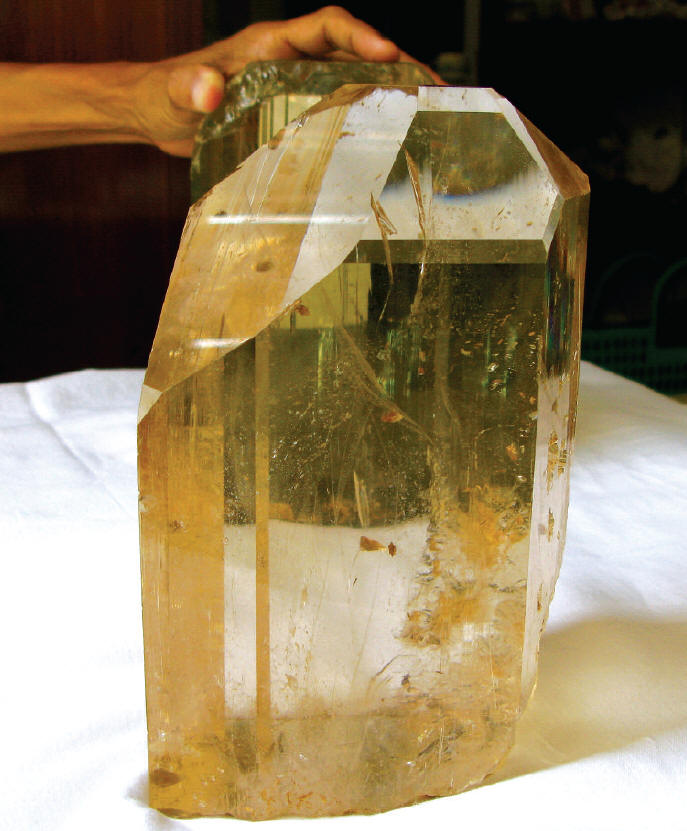
Superb gem topaz crystal weighing 4.5 kg! F. Bärlocher photo.
The majority of the pockets are locatedin the core zone of the pegmatitebodies, which are composed of quartz,feldspar, mica and accessory minerals.
Usually the pockets are not bigger than 1meter, but there have been some importantexceptions, including a pocket thatreached over 8 m!

Topaz crystal, 6.7 cm tall. Arkenstone specimen. J. Budd photo.
The paragenesis found in the pocketsis usually very simple, containingonly 4-5 different mineral species. Allpockets contain feldspars and mica, andthe majority of them also contain quartz.
Topaz, beryl and tourmaline are morerare. Occasionally other mineral speciesare found.
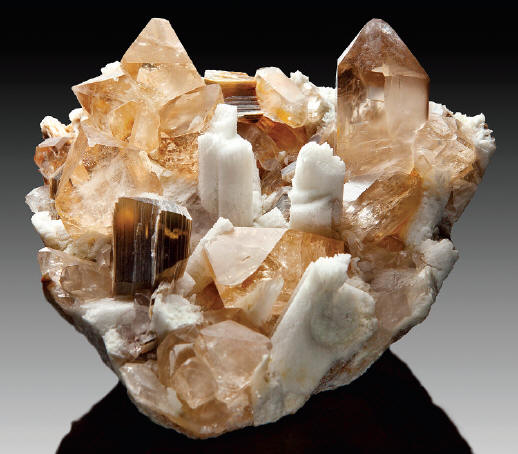
Topaz with quartz, muscovite and feldspar, 15 cm. Fine Minerals Intl. specimen. FMI-J. Elliott photo.
The best available information onwhat the cavities look like comes from one of the most important mines ownedby the Burmese medical doctor SawNaung Oo. He started his operation in2002 and for the first 4 years found almostnothing. Bonanza discoveries ofpockets took place in the years 2006-2007, but since then, in spite of continuousmining, not much new has beendiscovered. It is very likely that pocketsfound during the 2006-2007 periodformed a series of vugs located in thesame zone.
The first important pocket, called“the Aquamarine Pocket”, was hit in2006 and produced 198 specimens containinglustrous, gemmy aquamarinecrystals to over 10 cm long. Some of thecrystals are simple and sharp, while othersare etched and show interesting morphology.
The majority were extractedas loose, single crystals, but a few specimenswith quartz were recovered aswell. Some of crystals are doubly terminated.
Their colors range from light todeep blue. The biggest cut sone madefrom that find weighs 80 carats.

Topaz with quartz from Sakangyi pocket, 17 cm wide. Pala International specimen, now in the E. Long collection. J. Budd photo.
At the end of the same year anotherimportant pocket was found. It producedone of the biggest known quartz crystalsfrom the area – 78 kg! Quartz crystalsextracted from that pocket weigh altogetherabout 1.5 tons! Most of them arewater-clear and very lustrous.
The most extraordinary pocket, discoveredat the end of 2006, was filledwith mud so that its real size and qualitywere not apparent at first. After washingthe mud out the miners found that the pocket was approximately 1.5 m high, 2m wide and 8 m long! Clean, water-clearquartz crystals reaching 0.5 m hung fromthe roof and walls of the pocket, togetherwith giant feldspar and mica crystals.
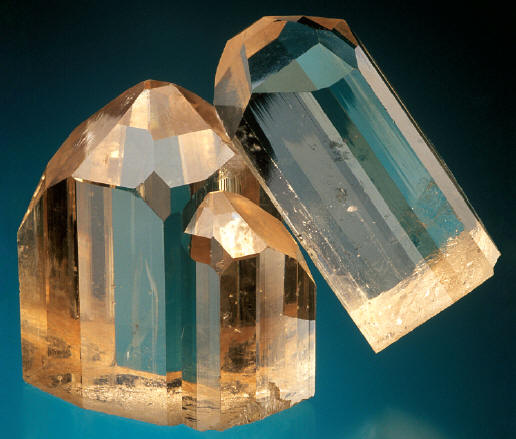
Cluster of topaz crystals, 9.5 cm high. W. Larson collection. J. Scovil photo.
Most importantly, a large number ofclean, gemmy topaz crystals, from colorlessto champagne-colored, were alsofound in the pocket. Some of these enormoustopaz crystals, reaching 20 cm, areshown in the photos here. After carefulextraction using only hand tools, hundredsof specimens were recovered fromthe pocket. The biggest cluster weighs178 kg and the biggest individual topazcrystal weighs 80 kg! Miners carriedthese monsters using bamboo and ropes:it looked as though hunters were bringingdeer into the village after a successfulchase.
This exceptional pocket may be consideredone of the world's most importanttopaz finds, having produced someof the best known topaz/quartz/feldsparmatrix specimens.
PERSPECTIVESMogok has a rich gem-mining historyand an expanding gem industry. It isalmost certain that the Sakangyi mineswill operate as long as pegmatites producegemstones and specimens, but it isvery difficult to predict whether anymore exceptional pockets will be found.
Today, with generally increasing use ofdigital cameras, there is a chance thatthe next extraordinary find will be documentedphotographically, creating atopic for another article about theSakangyi area.
ACKNOWLEDGEMENTSThe authors would like to thank severalpeople without whose contributionthis article couldn't have been written.
First of all, thanks to Doctor Saw NaungOo, who photographed the pocket andcontributed to the preservation of significantmineral specimens from the mine,and to his daughter, Mrs. Saw SandaSoe, who provided us with many importantdetails. Thanks also to FedericoB?rlocher, Bill Larson, Jeff Scovil, JamesElliot, Joe Budd, Mark Mauthner, KyawThu, Mia Dixon and Neal Luppescou forproviding the photos, and to Peter Lyckbergfor the help with additional information.
And last but not least we wouldlike to thank Tom Moore for editing thearticle, and Joanna Gajowniczek, Maryand Paul Cragan for their help with corrections.













 YueGongAnBei 44051102000467
YueGongAnBei 44051102000467


 |
|